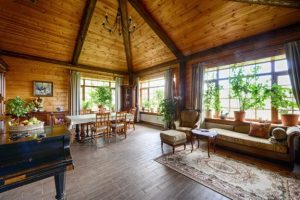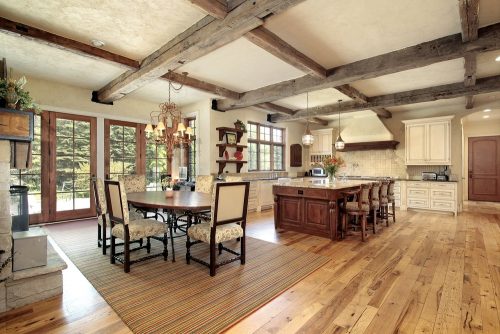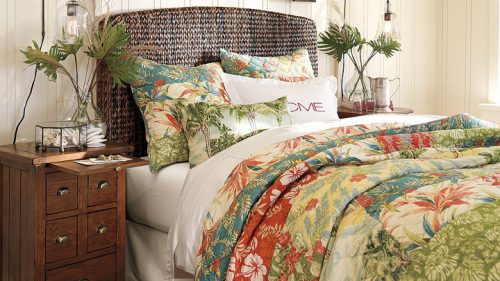The Colonial Style Revival

Today, say hello to colonial interiors with their grand entrance halls, sanded wooden floors, neutral palettes and gentle touch of woodwork and paneling. In the world of interior design, this style goes back to colonial times and borrows decor from the wealthy.
Some styles are always in. Others come and go with time. The colonial style is the former. It’s more popular than ever because of the warmth and serenity that it offers to both large and small spaces.
The origins of the colonial style
This particular style has a special cultural mix that makes it attractive. It’s inspired by the home decor of the old colonies in the nineteenth century as well as by artisan European furniture made with exotic woods in far away lands.
Teak and mahogany are colonial style protagonists. They take our minds far away to tropical, exotic Asian countries. Back in the day, artisans created large, sturdy furniture pieces. The most common pieces were folding screens, showcase cabinets, dressers, and bookcases.

Textiles
This style reflects nature. Linen is the preferred fabric for colonial settings and adds freshness to the overall decor. Linen can work for tapestries, curtains and large cushions on sofas or on the ground, creating a perfect setting. Thick cotton fabric is also an option for sofas or armchairs.
The colonial style also uses any kind of natural fiber that brings warmth, like the ratan or raffia that is sometimes on furniture. You might also find them in rugs, curtains, screens, mirror frames, lamps or other decorative elements. They’re always paired with dark woods.
Colonial style colors
The color palette for colonial homes is neutral. It ranges from white and includes all shades of cream, brown and ocher. Dark wood furniture pairs with white or beige tapestries; the floors are dark wood as well, playing with light, neutral walls.
The color comes from green plants and pillows as well as other decorative elements. They all work as long as they don’t go too far from the earthy tones, which vary between ocher and red.

For curtains, light-colored fabrics on dark wooden frames are the best option. These days, we can also find light-colored furniture in the colonial style. However, the authentic style uses exotic woods like iroko, mindi, teak or wenge. Stone, glass, and iron also add a little character to this style. In addition, bamboo and wicker are also good choices for small, decorative elements.
Accessories
In colonial homes, decorative accessories play a bigger role than they do in other styles: big trunks, candleholders, large iron or mother-of-pearl light fixtures, antique suitcases, and folding screens.
Canvas in natural tones and large ceramic pieces that are similar in color are also important decor pieces. There are plenty of home decor stores that specialize in these sorts of elements where you can find these marvelous items.
You have to choose your accessory pieces carefully. If you’re using large, colonial-style furniture pieces, you need to pick out just a few significant accessories. You have to first decide whether you want the furniture or the accessory pieces as your centerpiece.

A style that can’t fail
The colonial style is a variation of a classic contemporary one; it’s exotic and natural. For big homes that are surrounded by nature, the colonial style works stunningly; but it can also transform city homes and apartments beautifully. Once you go colonial, it’s hard to go back. Create fresh spaces that welcome you to live comfortably in them.
You can use this style for any room, even children’s rooms. The contrasts from the light fabrics and dark woods alongside the green plants will transport you to other times and places. It’s a style that never fails. You can decorate your home entirely with a colonial air, or just add a handful of elements to get that distant paradise effect.
Today, say hello to colonial interiors with their grand entrance halls, sanded wooden floors, neutral palettes and gentle touch of woodwork and paneling. In the world of interior design, this style goes back to colonial times and borrows decor from the wealthy.
Some styles are always in. Others come and go with time. The colonial style is the former. It’s more popular than ever because of the warmth and serenity that it offers to both large and small spaces.
The origins of the colonial style
This particular style has a special cultural mix that makes it attractive. It’s inspired by the home decor of the old colonies in the nineteenth century as well as by artisan European furniture made with exotic woods in far away lands.
Teak and mahogany are colonial style protagonists. They take our minds far away to tropical, exotic Asian countries. Back in the day, artisans created large, sturdy furniture pieces. The most common pieces were folding screens, showcase cabinets, dressers, and bookcases.

Textiles
This style reflects nature. Linen is the preferred fabric for colonial settings and adds freshness to the overall decor. Linen can work for tapestries, curtains and large cushions on sofas or on the ground, creating a perfect setting. Thick cotton fabric is also an option for sofas or armchairs.
The colonial style also uses any kind of natural fiber that brings warmth, like the ratan or raffia that is sometimes on furniture. You might also find them in rugs, curtains, screens, mirror frames, lamps or other decorative elements. They’re always paired with dark woods.
Colonial style colors
The color palette for colonial homes is neutral. It ranges from white and includes all shades of cream, brown and ocher. Dark wood furniture pairs with white or beige tapestries; the floors are dark wood as well, playing with light, neutral walls.
The color comes from green plants and pillows as well as other decorative elements. They all work as long as they don’t go too far from the earthy tones, which vary between ocher and red.

For curtains, light-colored fabrics on dark wooden frames are the best option. These days, we can also find light-colored furniture in the colonial style. However, the authentic style uses exotic woods like iroko, mindi, teak or wenge. Stone, glass, and iron also add a little character to this style. In addition, bamboo and wicker are also good choices for small, decorative elements.
Accessories
In colonial homes, decorative accessories play a bigger role than they do in other styles: big trunks, candleholders, large iron or mother-of-pearl light fixtures, antique suitcases, and folding screens.
Canvas in natural tones and large ceramic pieces that are similar in color are also important decor pieces. There are plenty of home decor stores that specialize in these sorts of elements where you can find these marvelous items.
You have to choose your accessory pieces carefully. If you’re using large, colonial-style furniture pieces, you need to pick out just a few significant accessories. You have to first decide whether you want the furniture or the accessory pieces as your centerpiece.

A style that can’t fail
The colonial style is a variation of a classic contemporary one; it’s exotic and natural. For big homes that are surrounded by nature, the colonial style works stunningly; but it can also transform city homes and apartments beautifully. Once you go colonial, it’s hard to go back. Create fresh spaces that welcome you to live comfortably in them.
You can use this style for any room, even children’s rooms. The contrasts from the light fabrics and dark woods alongside the green plants will transport you to other times and places. It’s a style that never fails. You can decorate your home entirely with a colonial air, or just add a handful of elements to get that distant paradise effect.







